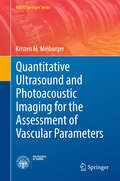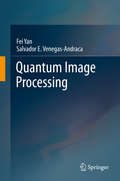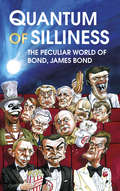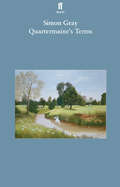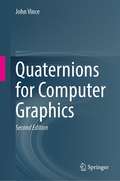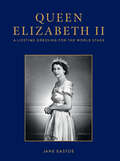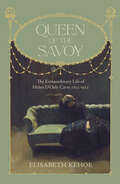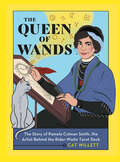- Table View
- List View
Quantitative Risk Assessment in Fire Safety
by Ganapathy Ramachandran David ChartersFire safety regulations in many countries require Fire Risk Assessment to be carried out for buildings such as workplaces and houses in multiple occupation. This duty is imposed on a "Responsible Person" and also on any other persons having control of buildings in compliance with the requirements specified in the regulations. Although regulations only require a qualitative assessment of fire risk, a quantitative assessment is an essential first step for performing cost-benefit analysis of alternative fire strategies to comply with the regulations and selecting the most cost-effective strategy. To facilitate this assessment, various qualitative, semi-quantitative and quantitative techniques of fire risk assessment, already developed, are critically reviewed in this book and some improvements are suggested. This book is intended to be an expanded version of Part 7: Probabilistic risk assessment, 2003, a Published Document (PD) to British Standard BS 7974: 2001 on the Application of Fire Safety Engineering Principles to the Design of Buildings. Ganapathy Ramachandran and David Charters were co-authors of PD 7974 Part 7. Quantitative Risk Assessment in Fire Safety is essential reading for consultants, academics, fire safety engineers, fire officers, building control officers and students in fire safety engineering. It also provides useful tools for fire protection economists and risk management professionals, including those involved in fire insurance underwriting.
Quantitative Risk Assessment in Fire Safety
by Ganapathy Ramachandran David ChartersFire safety regulations in many countries require Fire Risk Assessment to be carried out for buildings such as workplaces and houses in multiple occupation. This duty is imposed on a "Responsible Person" and also on any other persons having control of buildings in compliance with the requirements specified in the regulations. Although regulations only require a qualitative assessment of fire risk, a quantitative assessment is an essential first step for performing cost-benefit analysis of alternative fire strategies to comply with the regulations and selecting the most cost-effective strategy. To facilitate this assessment, various qualitative, semi-quantitative and quantitative techniques of fire risk assessment, already developed, are critically reviewed in this book and some improvements are suggested. This book is intended to be an expanded version of Part 7: Probabilistic risk assessment, 2003, a Published Document (PD) to British Standard BS 7974: 2001 on the Application of Fire Safety Engineering Principles to the Design of Buildings. Ganapathy Ramachandran and David Charters were co-authors of PD 7974 Part 7. Quantitative Risk Assessment in Fire Safety is essential reading for consultants, academics, fire safety engineers, fire officers, building control officers and students in fire safety engineering. It also provides useful tools for fire protection economists and risk management professionals, including those involved in fire insurance underwriting.
Quantitative Ultrasound and Photoacoustic Imaging for the Assessment of Vascular Parameters (PoliTO Springer Series)
by Kristen M. MeiburgerThis book describes the development of quantitative techniques for ultrasound and photoacoustic imaging in the assessment of architectural and vascular parameters. It presents morphological vascular research based on the development of quantitative imaging techniques for the use of clinical B-mode ultrasound images, and preclinical architectural vascular investigations on quantitative imaging techniques for ultrasounds and photoacoustics.The book is divided into two main parts, the first of which focuses on the development and validation of quantitative techniques for the assessment of vascular morphological parameters that can be extracted from B-mode ultrasound longitudinal images of the common carotid artery. In turn, the second part highlights quantitative imaging techniques for assessing the architectural parameters of vasculature that can be extracted from 3D volumes, using both contrast-enhanced ultrasound (CEUS) imaging and photoacoustic imaging without the addition of any contrast agent. Sharing and summarizing the outcomes of this important research, the book will be of interest to a broad range of researchers and practitioners in the fields of medical imaging and biomedical engineering.
Quantum Image Processing
by Fei Yan Salvador E. Venegas-AndracaThis book provides a comprehensive introduction to quantum image processing, which focuses on extending conventional image processing tasks to the quantum computing frameworks. It summarizes the available quantum image representations and their operations, reviews the possible quantum image applications and their implementation, and discusses the open questions and future development trends. It offers a valuable reference resource for graduate students and researchers interested in this emerging interdisciplinary field.
Quantum of Silliness: The Peculiar World of Bond, James Bond
by Robbie SimsWho gives the hammiest performance in a Bond film? What is the series’ most cringeworthy moment? What quips would Sir Roger Moore come out with if he starred in Licence to Kill? These are the sort of questions you never knew you needed answering. It’s Bond, James Bond – but as you’ve never seen him before.
The Quarantine Atlas: Mapping Global Life Under COVID-19
by Laura Bliss A Bloomberg CityLab ProjectThe Quarantine Atlas is a poignant and deeply human collection of more than 65 homemade maps created by people around the globe that reveal how the coronavirus pandemic has transformed our physical and emotional worlds, in ways both universal and unique. Along with eight original essays, it is a vivid celebration of wayfinding through a crisis that irrevocably altered the way we experience our environment.In April 2020, Bloomberg CityLab journalists Laura Bliss and Jessica Lee Martin asked readers to submit homemade maps of their lives during the coronavirus pandemic. The response was illuminating and inspiring. The 400+ maps and accompanying stories received served as windows into what individuals around the world were experiencing during the crisis and its resonant social consequences. Collectively, these works showed how coronavirus has transformed the places we live, and our relationships to them.In The Quarantine Atlas, Bliss distills these stunning submissions and pairs them with essays by journalists and authors, as well as notes from the original mapmakers. The result is an enduring visual record of this unprecedented moment in human history. It is also a celebration of the act of mapping and the ways maps can help us connect and heal from our shared experience.
QuarkXPress For Dummies
by Jay J. NelsonTake the kinks out of working with QuarkXPress QuarkXPress still remains one of the top tools for layout and design projects, even thirty years after it made its debut. This full-color, hands-on guide is here to help you take the guesswork out of using this powerful tool to create stunning print or digital designs. In QuarkXPress For Dummies, you'll find information on the latest changes to QuarkXPress, easy-to-follow, step-by-step guidance on using the tools built into the software to aid in designing and outputting visual product, and quick solutions to common Quark problems when you get stuck. QuarkXPress dominated the page layout world for decades. It's stuck around thanks to how it readily adapts to customer needs. This new version contains updates and features driven solely by customer feedback. That responsiveness is luring new and former users to the fold. That resurgence in the design community has Quark users clamoring for an authoritative book on how to use it to its fullest. Created in partnership with the pros at Quark, this is the book for new and experienced QuarkXPress users looking to make sense of the latest version. Offers unbeatable tricks for working with text Provides guidance on managing larger design projects Includes tips on how to correct mistakes Take a tour of the palettes, add style to your work, and make QuarkXPress work for you!
QuarkXPress For Dummies
by Jay J. NelsonTake the kinks out of working with QuarkXPress QuarkXPress still remains one of the top tools for layout and design projects, even thirty years after it made its debut. This full-color, hands-on guide is here to help you take the guesswork out of using this powerful tool to create stunning print or digital designs. In QuarkXPress For Dummies, you'll find information on the latest changes to QuarkXPress, easy-to-follow, step-by-step guidance on using the tools built into the software to aid in designing and outputting visual product, and quick solutions to common Quark problems when you get stuck. QuarkXPress dominated the page layout world for decades. It's stuck around thanks to how it readily adapts to customer needs. This new version contains updates and features driven solely by customer feedback. That responsiveness is luring new and former users to the fold. That resurgence in the design community has Quark users clamoring for an authoritative book on how to use it to its fullest. Created in partnership with the pros at Quark, this is the book for new and experienced QuarkXPress users looking to make sense of the latest version. Offers unbeatable tricks for working with text Provides guidance on managing larger design projects Includes tips on how to correct mistakes Take a tour of the palettes, add style to your work, and make QuarkXPress work for you!
Quartermaine's Terms: Quartermaine's Terms; The Rear Column; Close Of Play; Stage Struck; Tartuffe; A Month In The Country; The Idiot
by Simon Gray'A masterly portrayal of an innocent.' Harold Pinter, from 'Directing Simon Gray's Plays', Simon Gray Plays 1'Superficially, it is a light comedy about a group of educated, often eccentric English characters in an academic backwater in the early sixties. But though the jokes are excellent, the piece cuts deep. There are Strindberg-like glimpses of wretchedly unhappy marriages and, as in Ibsen, a sense of chickens coming home to roost. But the primary impression here is of an English Chekhov. As in the plays of the Russian master, the characters talk a lot, but they rarely listen, still less understand, so they are often at cross-purposes. And like The Seagull, the long time scheme in Quartermaine's Terms - it spans several years - creates a poignant sense of transience and mortality.' Daily Telegraph'Gray's selection of details and exchanges is immaculate: he achieves drama and mystery in mundane lives; the comedy is beautifully stated and even personal tragedies are underlined with running gags that ring with truthfulness. No false hothouse effect is necessary to make bare the bewilderment of spirit of his central figure, the grinning, forgetful and deeply kind staff lecturer, St John Quartermaine, an inarticulate character of awesome loneliness who rivals the tragic force of Willy Loman.' The Times 'A play that is at once full of doom and gloom and bristling with wry, even uproarious comedy. The mixture is so artfully balanced that we really don't know where the laughter ends and the tears begin: the playwright is in full possession of the Chekhovian territory where the tragedies and absurdities of life become one and the same.' New York Times
Quartier^4: Impulse für eine bedürfnisgerechte Quartiersgestaltung (Architekturen #78)
by Agnes Förster Nina Berding Angelina Bolten Paula ErckmannVon Quartieren kann und muss Wandel ausgehen, denn hier lässt sich das System Stadt von seiner kleinsten Einheit heraus transformieren. Die Autor*innen nehmen die Bedürfnisse des Menschen zum Ausgangspunkt und fragen danach, wie Wohnen, Freiraum, Bildung, Pflege, Mobilität und Versorgung auf Quartiersebene bestmöglich erfüllt werden können. Das Ergebnis ist eine Planungshilfe für Neubauquartiere bis hin zu Quartieren, die eingeschlafen sind und einen sanften Generationenwechsel benötigen. Ein umfangreiches Repertoire an Instrumenten bietet die Möglichkeit, Angebote und Services den Herausforderungen und Ressourcen im Quartier entsprechend zu koppeln, um eine sozialräumliche Entwicklung in Gang zu setzen.
Quatermass and the Pit: Five Million Years To Earth (BFI Film Classics)
by Kim NewmanWhile digging an extension to the London Underground Railway, workmen discover an object which might be an ancient Martian spaceship – and Professor Quatermass of the British Rocket Group investigates a mystery which prompts frightening revelations about the origins of humanity itself. Before 2001: A Space Odyssey and Doctor Who, Quatermass and the Pit was the paramount British science fiction saga in film and television. Kim Newman's fascinating study focuses on Roy Ward Baker's 1967 film, written by Quatermass creator Nigel Kneale for Hammer Films, but also looks at the origins of the Quatermass franchise in 1950s BBC serials and earlier films. Exploring the production and reception of the film and series, Newman assesses the lasting importance of this landmark franchise.
Quaternion and Clifford Fourier Transforms and Wavelets (Trends in Mathematics)
by Eckhard Hitzer Stephen J. SangwineQuaternion and Clifford Fourier and wavelet transformations generalize the classical theory to higher dimensions and are becoming increasingly important in diverse areas of mathematics, physics, computer science and engineering. This edited volume presents the state of the art in these hypercomplex transformations. The Clifford algebras unify Hamilton’s quaternions with Grassmann algebra. A Clifford algebra is a complete algebra of a vector space and all its subspaces including the measurement of volumes and dihedral angles between any pair of subspaces. Quaternion and Clifford algebras permit the systematic generalization of many known concepts. This book provides comprehensive insights into current developments and applications including their performance and evaluation. Mathematically, it indicates where further investigation is required. For instance, attention is drawn to the matrix isomorphisms for hypercomplex algebras, which will help readers to see that software implementations are within our grasp. It also contributes to a growing unification of ideas and notation across the expanding field of hypercomplex transforms and wavelets. The first chapter provides a historical background and an overview of the relevant literature, and shows how the contributions that follow relate to each other and to prior work. The book will be a valuable resource for graduate students as well as for scientists and engineers.
Quaternions for Computer Graphics
by John VinceIf you have ever wondered what quaternions are — then look no further, John Vince will show you how simple and useful they are. This 2nd edition has been completely revised and includes extra detail on the invention of quaternions, a complete review of the text and equations, all figures are in colour, extra worked examples, an expanded index, and a bibliography arranged for each chapter. Quaternions for Computer Graphics includes chapters on number sets and algebra, imaginary and complex numbers, the complex plane, rotation transforms, and a comprehensive description of quaternions in the context of rotation. The book will appeal to students of computer graphics, computer science and mathematics, as well as programmers, researchers, academics and professional practitioners interested in learning about quaternions. John Vince explains in an easy-to-understand language, with the aid of useful figures, how quaternions emerged, gave birth to modern vector analysis, disappeared, and reemerged to be adopted by the flight simulation industry and computer graphics. This book will give you the confidence to use quaternions within your every-day mathematics, and explore more advanced texts.
Quebec Cinema in the 21st Century: Transcending the National (Contemporary French and Francophone Cultures #95)
by Michael Gott and Thibaut SchiltThis collection of ten chapters and three original interviews with Québécois filmmakers focuses on the past two decades of Quebec cinema and takes an in-depth look at a (primarily) Montreal-based filmmaking industry whose increasingly diverse productions continue to resist the hegemony of Hollywood and to exist as a visible and successful hub of French-language – and ever more multilingual – cinema in North America. This volume picks up where Bill Marshall’s 2001 Quebec National Cinema ends to investigate the inherently global nature of Quebec’s film industry and cinematic output since the beginning of the new millennium. Through their analyses of contemporary films (Une colonie, Avant les rues, Bon cop, bad cop, Les Affamés, Tom à la ferme, Uvanga, among others), directors (including Xavier Dolan, Denis Côté, Sophie Desrape, Chloé Robichaud, Jean-Marc Vallée, and Monia Chokri) and genres (such as the buddy comedy and the zombie film), our authors examine the growing tension between Quebec cinema as a “national cinema” and as an art form that reflects the transnationalism of today’s world, a new form of fluidity of individual experiences, and an increasing on-screen presence of Indigenous subjects, both within and outside the borders of the province. The book concludes with specially conducted interviews with filmmakers Denis Chouinard, Bachir Bensadekk, and Marie-Hélène Cousineau, who provide their views and insights on contemporary Quebec filmmaking.
Quebec Cinema in the 21st Century: Transcending the National (Contemporary French and Francophone Cultures #95)
This collection of ten chapters and three original interviews with Québécois filmmakers focuses on the past two decades of Quebec cinema and takes an in-depth look at a (primarily) Montreal-based filmmaking industry whose increasingly diverse productions continue to resist the hegemony of Hollywood and to exist as a visible and successful hub of French-language – and ever more multilingual – cinema in North America. This volume picks up where Bill Marshall’s 2001 Quebec National Cinema ends to investigate the inherently global nature of Quebec’s film industry and cinematic output since the beginning of the new millennium. Through their analyses of contemporary films (Une colonie, Avant les rues, Bon cop, bad cop, Les Affamés, Tom à la ferme, Uvanga, among others), directors (including Xavier Dolan, Denis Côté, Sophie Desrape, Chloé Robichaud, Jean-Marc Vallée, and Monia Chokri) and genres (such as the buddy comedy and the zombie film), our authors examine the growing tension between Quebec cinema as a “national cinema” and as an art form that reflects the transnationalism of today’s world, a new form of fluidity of individual experiences, and an increasing on-screen presence of Indigenous subjects, both within and outside the borders of the province. The book concludes with specially conducted interviews with filmmakers Denis Chouinard, Bachir Bensadekk, and Marie-Hélène Cousineau, who provide their views and insights on contemporary Quebec filmmaking.
The Queen: 70 years of Majestic Style
by Bethan HoltThe past 70 years have seen a 25-year-old Princess transform into a nonagenarian monarch who is respected and loved the world over. A woman whose views are never heard, Queen Elizabeth II has deployed fashion as a means to communicate and signal her position to the crowds who gather to see her in public and the millions who watch her television broadcasts: ‘I must be seen to be believed,’ she has said. The Queen’s evolving attitude to dress reflects a visual landscape that began as genteel reportage in mostly black and white and has over the years evolved into today’s technicolour 24/7 news cycle, flashed around the world in seconds and driven by social media. Incredibly, in her 70th year as monarch, the Queen feels as relevant as ever before – and she is, undoubtedly, a style icon. The Queen: 70 Years of Majestic Style celebrates the fashion evolution of Elizabeth II in her unprecedented Platinum Jubilee year.
Queen Christina (BFI Film Classics)
by Marcia Landy Amy VillarejoEach volume in the 'BFI Film Classics' series features a brief production history, detailed filmography, notes and bibliography. This text explores MGM's 1933 production of 'Queen Christina', starring Greta Garbo, from a feminist perspective. The authors explore the role of Christina, who, fleeing an arranged marriage, is forced to disguise herself as a man. They read the film partly from a lesbian perspective, as well as looking at other ways in which gender and power impose contradictory pressures.
Queen Christina (BFI Film Classics)
by Marcia Landy Amy VillarejoEach volume in the 'BFI Film Classics' series features a brief production history, detailed filmography, notes and bibliography. This text explores MGM's 1933 production of 'Queen Christina', starring Greta Garbo, from a feminist perspective. The authors explore the role of Christina, who, fleeing an arranged marriage, is forced to disguise herself as a man. They read the film partly from a lesbian perspective, as well as looking at other ways in which gender and power impose contradictory pressures.
Queen Elizabeth II: A Lifetime Dressing For The World Stage
by Jane EastoeExquisite and sumptuous, immaculately tailored, dignified and, above all, practical. The wardrobe of Queen Elizabeth II was as distinctive in style as her position in the world was unique. This remarkable book is a fond reflection of the days when her Majesty led the field in fashion, showcasing some of the world's best designers.
Queen Elizabeth II: A Celebration of Her Life and Reign in Pictures
by David SoudenAn official BBC book that celebrates the life of Queen Elizabeth II through photographs, some rarely seen, drawn largely from archives of the BBC.The longest-reigning monarch in British history, Queen Elizabeth II has been at the centre of British life for almost a century. She's led a very public life, seen by millions through photographs, film and television, from the time of her birth in 1926 to the final years of her reign. The embodiment of Britain, she has been a constant, knowledgeable presence in our politics and culture since she came to the throne in 1952. This book celebrates the life of Queen Elizabeth II through photographs and still images, drawn largely from the archives of the BBC, an organisation that received its royal charter only one year after she was born. From her earliest days and first moments of public life, to her Platinum Jubilee and the weddings of her children and grandchildren, this is a lavish tribute to the most public of monarchs, an iconic figure in the hearts and minds of millions throughout the world.
Queen of The Savoy: The Extraordinary Life of Helen D’Oyly Carte 1852-1913
by Elisabeth KehoeBorn in 1852 in a small coastal town in Scotland, Helen D’Oyly Carte, through academic brilliance and an incredible talent for ‘managing chaos’, developed and ran the world’s foremost top entertainment and hospitality organisation with her husband, Richard D’Oyly Carte (known as D’Oyly). By the age of 30, she was running five Gilbert & Sullivan companies for the Savoy Group in the United States, crossing the Atlantic thirty times, and for the next three decades she ran the Savoy Theatre, the Savoy Hotel, Claridges and Simpson's-in-the-Strand. She was the only one trusted by the prickly, brilliant William Gilbert and Arthur Sullivan, to keep them from breaking apart, as they so regularly wanted to do. From a conventional upbringing, she chose to remain in London after the emigration of her family to Australia, first as an actress, then working alongside D’Oyly – she took over the reins as he became ill in the late 1880s. Until her death in 1913, she flourished and was famous, interviewed and admired, in a competitive, vibrant London that was the centre of world power and commerce. Queen of The Savoy charts Helen’s course from Wigtown to the West End, where running a company with hundreds of employees, led to her fame and fortune. The artists Whistler and Sickert were friends and immortalised her in portraits. She was known in her time as the true founder of the Gilbert and Sullivan franchise and this biography will bring to light, some 110 years after her death, the extraordinary role that she played in one of Britain’s greatest success stories.
The Queen of Wands: The Story of Pamela Colman Smith, the Artist Behind the Rider-Waite Tarot Deck
by Cat WillettDiscover the life, work, and magic of Pamela Colman Smith, the visionary artist behind the Rider-Waite-Smith Tarot Deck, the most popular and renowned divination deck in the world. With rich imagery, stunning colors, and an iconic place in the realm of divination, the Rider-Waite Tarot is perhaps the best known deck in the world. Seasoned readers and fledgling diviners alike turn to these cards in search of inspiration, understanding, and even a hint at the future. But the story of their origin is less well known, with their brilliant creator's name stripped away from them for decades. Now, for the first time, mystics, art-lovers, and fortune-tellers will uncover the magical story of Pamela Coleman Smith, rendered in full-color illustrations by artist Cat Willett, and inspired by the work of Pamela herself. From a childhood spent between the United Kingdom and Jamaica, to early artistic success in New York, to involvement in the secret occult society Order of the Golden Dawn, Pamela -- or Pixie, as she was known to many -- had a life full of enchanted inspiration and profound hardship. Through it all, her art acted as a guiding force, culminating in her custom illustrations for the deck that would become the Rider-Waite Tarot. Though she received little money and almost no credit for her contributions to the magical realm in her lifetime, Pixie's impact on tarot, divination, and the worlds of mysticism and the arts have reverberated for nearly 150 years, and her story serves as an enchanted spark. Depicted in whimsical, full-color detail, with interludes tying Pamela to the resurgence of modern magic and the world of tarot throughout, this singular work is a must-read for witches, creatives, and activists.
Queen Victoria and the Theatre of Her Age
by R. SchochA fresh and intimate portrait of Queen Victoria 'at the play'. Through Victoria's diary, artwork and correspondence we see her as enraptured spectator, bountiful patron and tyrannical director of private theatricals. At times she appears formidable. More frequently she is impudent, high-spirited and unruly; a woman who delights in gory melodramas and circus acts. Queen Victoria and the Theatre of Her Age gives readers a deeply personal account of her lifelong devotion to the stage. It will appeal to anyone interested in monarchy's place in popular culture.
The Queening of America
by David Van LeerSince at least the end of the nineteenth century, gay culture - its humour, its icons, its desires - has been alive and sometimes even visible in the midst of straight American society. David Van Leer puts forward here a series of readings that aim to identify what he calls the "queening" of America, a process by which "rhetorics and situations specific to homosexual culture are presented to a general readership as if culturally neutral." The Queening of America examines how the invisibility of gay male writing, especially in the popular culture of the 1950s and 1960s, facilitated the crossing of gay motifs in straight culture. Van Leer then critiques some current models of making homosexuality visible (the packaging of Joe Orton, the theories of Eve Kosofsky Sedgwick, the rise of gay studies), before concluding more optimistically with the possible alliances between gay culture and other minority discourses.
The Queening of America
by David Van LeerSince at least the end of the nineteenth century, gay culture - its humour, its icons, its desires - has been alive and sometimes even visible in the midst of straight American society. David Van Leer puts forward here a series of readings that aim to identify what he calls the "queening" of America, a process by which "rhetorics and situations specific to homosexual culture are presented to a general readership as if culturally neutral." The Queening of America examines how the invisibility of gay male writing, especially in the popular culture of the 1950s and 1960s, facilitated the crossing of gay motifs in straight culture. Van Leer then critiques some current models of making homosexuality visible (the packaging of Joe Orton, the theories of Eve Kosofsky Sedgwick, the rise of gay studies), before concluding more optimistically with the possible alliances between gay culture and other minority discourses.

